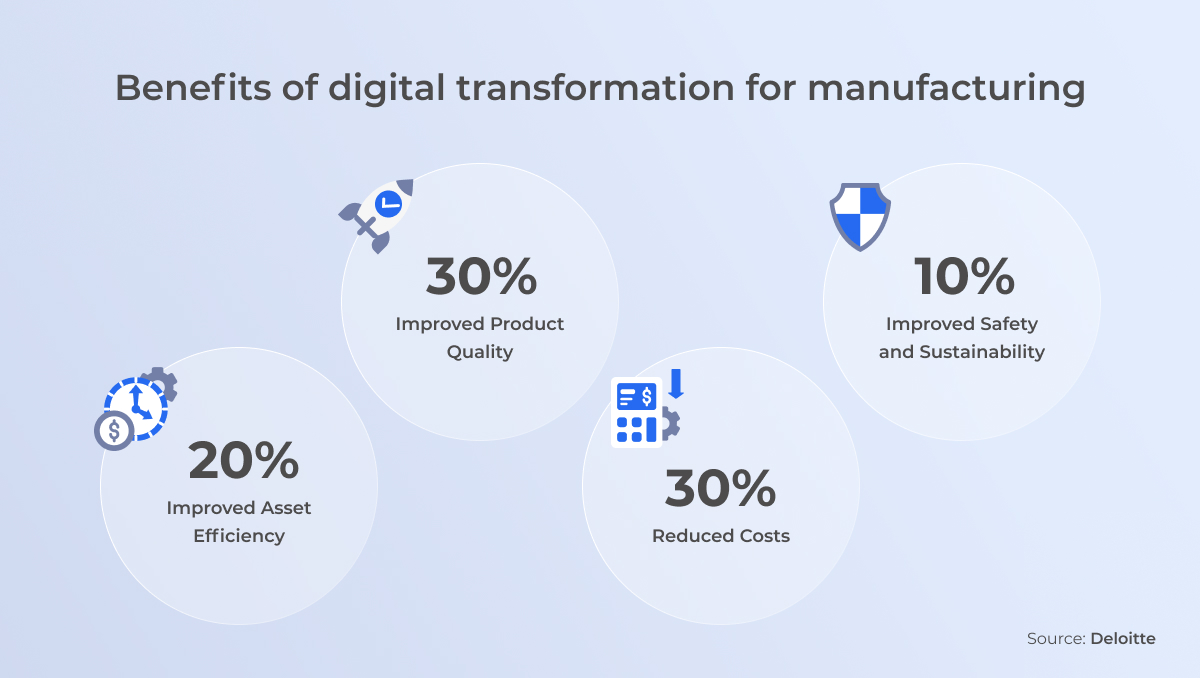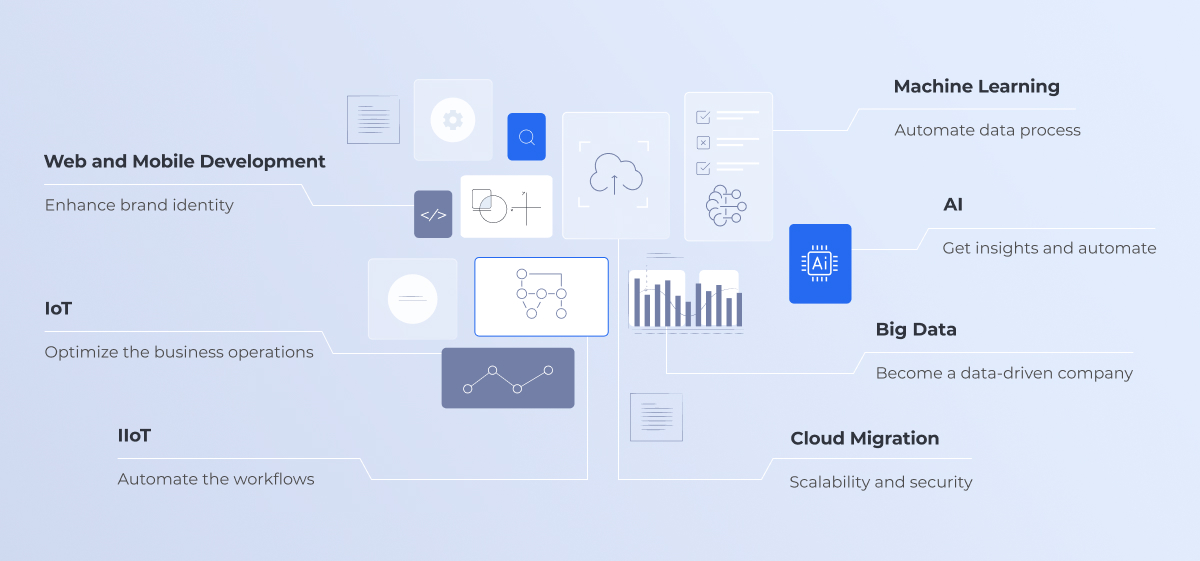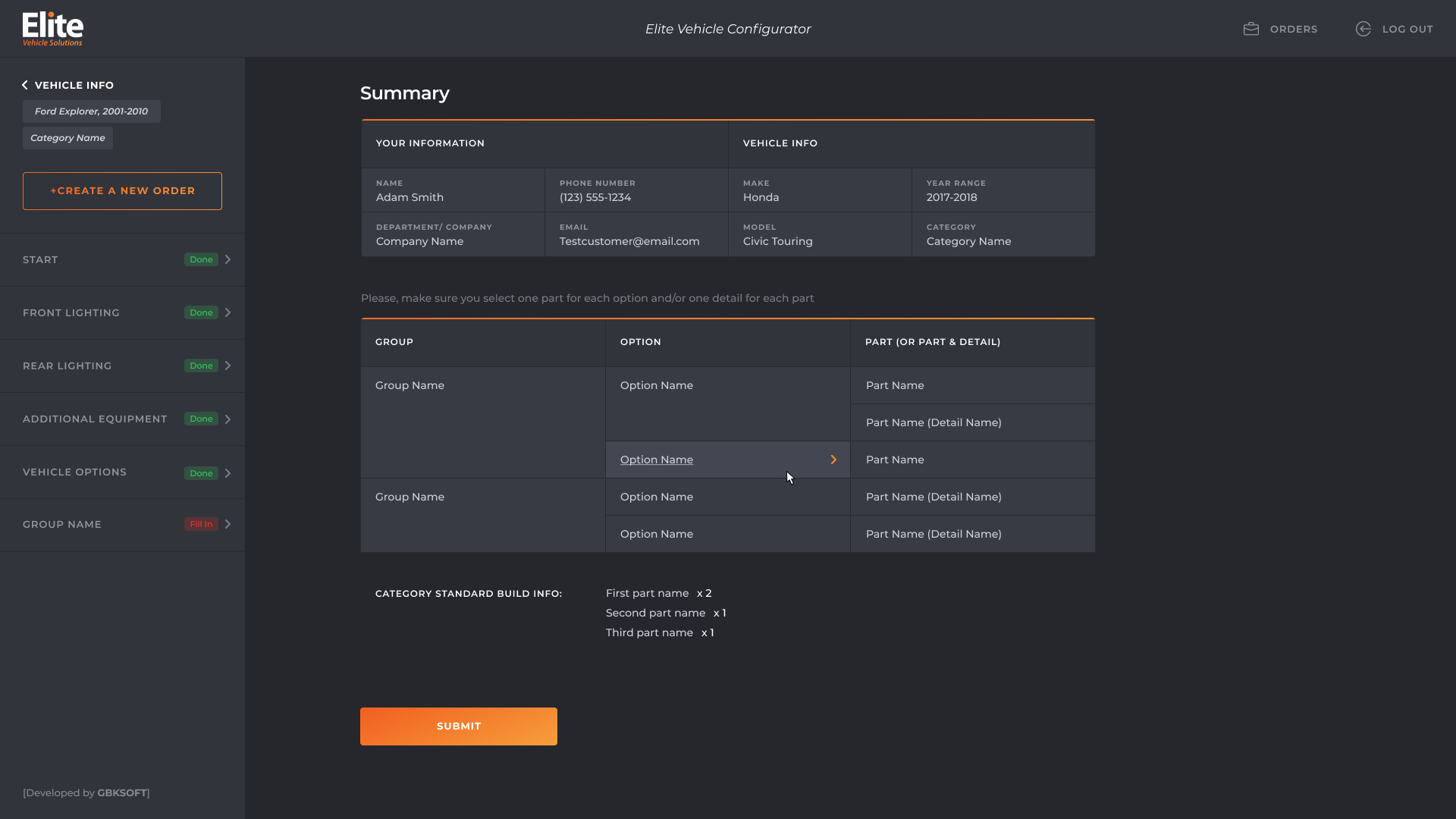Since manufacturing took the stage, it has gone through several crucial turns. Nowadays, we live in the era of the fourth industrial revolution that brings Industry 4.0 to life. Automation technologies have become more sophisticated. They aren’t just programmed to execute routine patterns, but to take over a part of the independent decision-making process and optimization.
Efficient, practical data usage is a driver for these changes. That’s how a smart factory was born from the connectivity of the three major components: people, assets, and data. Accepting appropriate digital technologies takes operations to a whole new level. However, digital transformation brings its own challenges.
First, it should never be done for the sake of being innovative — the decision should be calculated, and thoroughly contemplated to determine the best strategy for your company. You can start your journey with this article, as we will guide you through the main aspects and technologies of digital transformation in manufacturing and approaches to its implementation.
The Impact of Digital Transformation on Manufacturing
The pivotal change brought by digital transformation increases productivity. It directly affects the volumes of manufacturing, incomes and in the long run, the economy itself. In the last decade, labor productivity only depended on the number of man-hours. That is something that was inherited from the previous decades. The concept of a smart factory became a game-changer that, according to some predictions, may provide around 2% CAGR labor productivity growth.

The digital transformation alternates the traditional approaches to manufacturing. Factories that traditionally were cumbersome and steadfast, require a certain amount of flexibility and adaptability to stay profitable and relevant in the modern world. These features are easily gained through the implementation of digital technologies we will talk about in this article later.
But what about the tangible benefits of digital transformation in manufacturing? We will highlight the observation of manufacturers that have already switched to a partial smart factory concept at least.
So, smart factories:
- grant real-time insights into operations that can be optimized immediately;
- improve production capacity without significant changes in expenses or product quality;
- take care of many routine tasks and reduce manual workload without compromising on the quality or cost;
- improve the safety of the work environment and reduce the number of workplace accidents and injuries;
- maintain product integrity and take care of operational activities of the shop;
- speed up the production cycle;
- optimize the resource usage and operation process.
However, despite the obvious value of digital transformation in manufacturing, only a small part of manufacturers have reached the highest stage of this process. According to Deloitte, 1% percent of surveyed manufacturers completed the transformation of at least 1 facility in the EMEA (Europe, Middle East, Africa) region. There, 71% are currently working on it, and 28% plan to start the process.
As you can see, it’s quite possible that your competitors are only starting to grasp the power of smart manufacturing. While most of the manufacturers may be stuck doing things the old way, you have a chance to grow and gain those competitive advantages that will take you ahead of them.
Top Digital Transformation Trends in Manufacturing
The smart factory is powered by dozens of technologies. Most of them take care of seamless and fast data analysis and automatization of the production lines. The usage and implementation may vary from factory to factory, but the main technology remains the same at the core.
Cloud Computing
Cloud technology makes the whole process of data storage and exchange easier. While cooperating with cloud service providers and using their services like IaaS (Infrastructure as a Service), PaaS (Platform as a Service), or SaaS (Software as a Service), you receive a great amount of flexibility and variability.
Smart factories are a new milestone in the development of manufacturing, but the cloud is one of the main technologies that make it possible. Instead of isolated data silos, factories switch to the full data integration and exchange between advanced applications, machines, and people. Cloud brings speed, accessibility, and a smart, practical approach to data implementation.
Changing the capacities of your IT infrastructure is a matter of a minute with cloud services: send a request, and you will be granted an additional virtual CPU. It works vice versa as well. In times of transformations, upgrades, or the implementation of big data technologies, the cloud will give the required support to go smoothly through the changes.
Using cloud services will also take away a part of financial and operating pressure. Firstly, every provider has a professional support team who will take care of any issues or challenges connected with cloud functioning. Hence, you don’t need to assign any resources to handle this risk. Secondly, cloud services are usually flexible in terms of payment, and the company would be charged on a consumption basis. Considering that you won’t need to invest in additional servers and other hardware, it isn’t financially challenging.
Industrial IoT & Robotics
Automation is a great deal of success right now. Smart sensors, powered by IoT, and industrial robots are in charge of that. Most manufacturers focus on streamlining their production and reducing human involvement. A quarter of them names IoT and robots as a technology that will play a big role in their business in the next three years.
The Industrial Internet of Things relies on a network of smart sensors that connect factory assets through the Internet. With them, it’s possible for the business:
- to run predictive maintenance of equipment and fix it before it goes out of commission;
- create digital twins and run real-time simulations of the physical objects that are used in the production;
- monitor the state of facilities and so on.
Manufacturing robots are designed to conduct repetitive tasks that also may be dangerous for people to perform. Smart robots can be fully automated and used for high-volume production. A decade ago, it was technology available only for manufacturing giants, but now dozens of companies release different types of robots, including middle-sized and small factories.
The biggest value of the IoT and smart robots is in the change of focus. Monitoring and routine operations are no longer in the hands of employees. It is technologies that run the show. The predictive approach replaces the reactive one. Instead of concentrating on production working correctly and safely, employees have a chance to switch to more profound and strategic tasks.
Artificial intelligence
Data is a key, and artificial intelligence (AI) is an important success factor. IoT sensors and robots may gather valuable data, but the AI capacities will get you to real, efficient data usage.
With combined efforts of AI and machine learning, you will receive a strong tool that can reinvent the whole system of your manufacturing. Augmented analytics, based on AI and the IIoT, can increase the speed and quality of operational decisions. Predictive analytics, as well as predictive maintenance, helps to get a hold of equipment issues before they become critical. AI-powered computer vision increases the speed and accuracy of production and orders sent to the customers and ensures the quality of products.
There are a lot of use cases of artificial intelligence, and quite frankly, it might be the main link of the digital transformation in manufacturing. Combined with other technologies and the self-learning capability, it drives factories to a new level of data-driven, accurate decisions.
Additive manufacturing
Additive manufacturing (AM) is based on 3D printing, and it brings a new word to the production of goods and spare parts. AM allows easy manufacturing of complex objects with less time and more flexibility.
Many manufacturers still rely on analog approaches, while AM is based on digital technologies. The object that needs to be produced is prototyped with the help of computer-aided-design (CAD) software and then “printed” layer by layer.
AM creates light products with complex designs that can’t be built with traditional equipment. Its advantages include cost-effectiveness and a shorter time to market. The manufacturers don’t need bulky machines, dozens of processes anymore. Many industries have already benefited from AM, including aerospace, automotive, or healthcare.
Manufacturing ERP System
Enterprise resource planning systems exist in the business environment since the late 90s. But now it’s time to reinvent old-school ERP systems and make them more efficient and agile. Modern ERPs are designed to work in tandem with IoT, AI. This way, they bring enhanced automation and create the basis for profound decision-making.
However, to succeed, you need to choose the right ERP system. It should accommodate your business processes and whole supply chain. The main specific manufacturing ERP functions that you may need are:
- production module;
- supply chain management;
- order and inventory management;
- purchasing;
- material requirement planning;
- capacity requirements planning;
- planning & scheduling;
- integration with heavy machinery.
Another aspect you should pay attention to is the flexibility of the system. If it can’t be customized enough, you might gain more problems than obtaining any real benefit.
That’s why we suggest choosing custom ERP development instead of resorting to ready-made solutions. Our experience shows that custom-developed ERP is more convenient to use and simpler to implement, it is easier to support it and scale it up if your company is growing.
We can offer you the development of a self-sufficient ERP system. Our approach includes deep preliminary researches and the Discovery stage. They allow us to better understand your business model, internal processes and create software that will be 100% compatible and useful for your manufacturing.
Challenges of Digital Transformation in Manufacturing
Like with any significant change, digital transformation disturbs the usual way of things. This period may cause some difficulties and expose the company to new issues. It will demand some flexibility and effort from every single participant, but in the end, it will only bring a positive result. So here are the main risks you may encounter.
Employee resistance
People like stability, so major changes in their work will only cause distress and disturbance, which may lead even to sabotage of your digital transformation. But it can be resolved with adequate communication from C-level management and team leads. Explain to your employees why digital transformation is necessary, what changes are awaiting them, what involvement is needed from their side and what benefits it will bring for the company and them.
Lack of strategy and expertise
Digital transformation requires a thorough approach and sufficient expertise. Without a clear understanding and strategy, you won’t succeed or reach the final point of this process.
You can just rush through digital transformation or adopt new technologies only for the sake of them. Consult with specialists, determine what changes you realistically need, involve a qualified IT vendor, and go through transformation step-by-step.
Legacy infrastructure and business model
It’s also possible that your business needs to give up some processes or approaches to reach the next level of growth. Old infrastructure, outdated processes, paperwork may be in the way. Your company should be ready to reinvent itself from the core if it wants to embrace advanced technologies and stay competitive among the competitors.
Cybersecurity
Unfortunately, new technologies now only improve the performance but expose the company to cyber threats. IoT devices, the major part of smart factories, are very weakly protected from hackers. Even one poorly protected sensor may lead to big intrusion with data leaks or disruptions in your processes.
Your IT team should focus on cybersecurity and constantly monitor your networks. We have a few tips on how to protect your IoT system from intruders. Use them to establish cybersecurity practices in your renovated manufacturing.
Digital Transformation Manufacturing Case Study
Big market players in many fields have already embraced new technologies and gone through some stages and challenges of digital transformation in manufacturing. Let’s check the most interesting cases.
Bosch
Bosch, an engineering company, specializing in consumer goods and industrial technologies, has a great example of a smart factory. Bosch Automotive Diesel System factory is situated in Wuxi, China. Its concept is based on Big Data analysis. With constant real-time monitoring, the factory is able to collect and process data, related to the real state of equipment and conduct appropriate measures of maintenance. Senior vice-president of manufacturing and quality management Christophe Chapdelaine states that this process lowers the number of tools in use (hence costs), and maximizes the tool life cycle.
Caterpillar
Caterpillar, a huge construction equipment manufacturer, has implemented a number of solutions to its production process. To provide clients with better services, the company rapidly embraces and develops digital technologies. IIoT and augmented reality are used to run predictive maintenance of the heavy machinery and help employees through the challenges of troubleshooting or other tasks.
General Electric
General Electric, a multinational conglomerate operating in aviation, healthcare, power, and renewable energy, resorted to 3D printing for Leap engine creation. It is used in aviation by Airbus and Boeing now. Every engine consists of 20 parts, which now are made by Direct Metal Laser Melting (one of the types of additive manufacturing). As a result, each part becomes five times stronger than details made with a more classical manufacturing process.
Altamira — Your Reliable Partner for Digital Transformation
Digital transformation in manufacturing may be challenging: it is a long and resource-demanding process. You may struggle to determine the most appropriate technologies and their usage, and different complications may arise. But with the help of the right partner, the changes will go smoothly and painlessly.
Altamira has more than a decade of experience in helping companies improve their performance through the implementation of software. Our multi-functional team can help you determine the best strategy for your digital transformation, and develop custom software, tailored for your manufacturing.
We can help you with the next technologies:

Our Success Stories of Digital Transformation in Manufacturing
We gathered some major cases we successfully completed in this field.
Elite Vehicle — Order Management System for Vehicle Customization

The client is a provider of custom parts for special vehicles like ambulances, police cars, etc. Every order required a lot of manual work: employees needed to define all parts of the vehicle required, then create the list of them, send them to the supplier and install them. The process was cumbersome and took a lot of time.
The goal of the client was to automate and optimize the flow. This way, each order would take less time, the level of services would increase as no orders would be lost or forgotten. We created a smart platform that automates the process of order creating, proceeding, and requesting the required parts from the supplier.
Leo — Highly Functional Construction Management System

Our client is a manufacturer of concrete materials for the construction industry. After 10 years of work, the company tried different software solutions to improve productivity, automate the estimation process and simplify scheduling and quality assurance. The previous experience was unsuccessful, so the company started the cooperation with us and received a satisfying result.
We created a custom highly functional construction management system that powers the full cycle of every project. And finally, our client obtained a software system that fulfills the needs of the company and automates a significant part of repetitive tasks.
Want to save and share this info? Download PDF overview of this article and send it to your colleagues!
In Conclusion
Digital transformation in the manufacturing industry has already arrived. However, most companies think about it more than actually work on its implementation. Manufacturing is entering a new era. People switch to more profound responsibilities and take care of strategic and creative decisions, while routine tasks are done better, quicker, and more accurately by machines and technologies.
Manufacturers are bound to embrace this change if they want to reach higher performance, lower costs, and better quality. Your transformation may start small, with the implementation of the management systems, and accelerate through time.
However, the success of your digital transformation is determined by the approach you choose. A smart, thoughtful pace will help you pick the most efficient technologies for your factory and reach the highest results.






